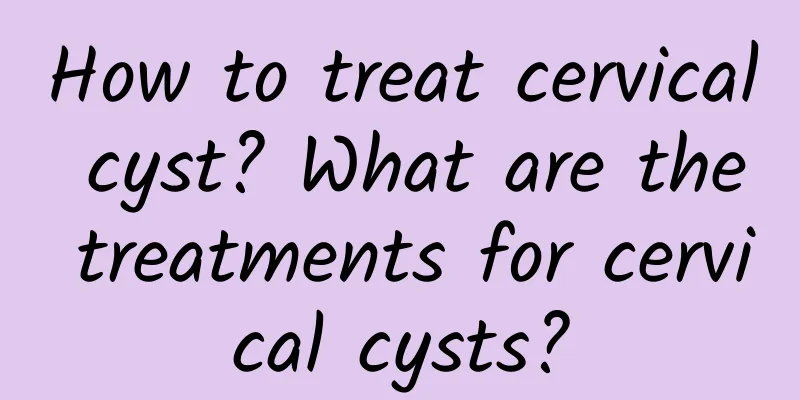How to treat cervical cyst? What are the treatments for cervical cysts?

|
Cervical cyst is a common gynecological disease and a pathological manifestation of chronic cervicitis in women. It is also called Nathian gland cyst. Cervical cysts are common in women aged 25-52, with an average age of onset of 36 years. So how to treat cervical cysts? 1. The cysts are small and scattered: If the cervical cysts are small and scattered, this type of cervical cyst generally does not require treatment. Just go to the hospital for annual check-ups, do cervical smears, and observe the degree of dispersion and changes in the cysts to prevent the occurrence of cervical cancer and precancerous lesions. 2. The cysts are small and dense or large and dense: The treatments for this type of cervical cysts include general treatment, surgical treatment, physical therapy, etc. (1) General treatment: The general treatment is mainly to use feminine care liquid to clean the vulva for minor infections, so as to prevent harmful bacteria from invading the vagina and inducing inflammation. Because harmful bacteria will first enter the female vaginal vault and cervix from the mucosa and wrinkles of the side walls of the vagina, thereby inducing vaginitis and causing inflammation. (2) Surgical treatment: Surgical treatment is used to treat cervical cysts larger than 3 centimeters. If medication cannot control the condition, in order to prevent the cyst from continuing to grow, surgical treatment should be performed as soon as possible to control the growth of the cyst in time. Commonly used surgical methods for cervical cysts include LEEP knife (Lip knife or ultra-high frequency radiofrequency knife), BBT self-coagulation knife (radio frequency minimally invasive self-coagulation knife), hysteroscopy and other minimally invasive surgeries. Surgical resection treatment is followed by auxiliary drug treatment to accelerate the repair of the cervix. (3) Physical therapy: Physical therapy methods include phototherapy, laser, microwave, cryotherapy, STG high-frequency radio wave technology, ultrasound, etc. ① Traditional physical therapy methods: Traditional physical therapy for cervical cysts mainly uses laser, freezing, microwave and other methods. ②STG high-frequency radio wave technology: STG high-frequency radio wave technology is currently the best physical therapy for treating cervical cysts. Compared with the LEEP knife used initially, STG high-frequency radio wave technology can locate more accurately and only remove the lesion tissue without damaging the normal cervix. STG high-frequency radio wave technology has the characteristics of one-time cure, less trauma, less pain, short treatment course, and complete tissue specimens. After treatment with STG high-frequency radio wave technology, women's reproductive function can be preserved. The cervix can recover two months after treatment, and pregnancy and childbirth can be achieved after three months. ③Ultrasound: It is an ultrasonic focused knife, and its energy source is ultrasound. The focused ultrasound knife commonly used in cancer treatment can also be used to treat cervical cysts. The treatment of cervical cysts utilizes the good penetrability of ultrasound. When ultrasound passes through the surface of tissue, it will not damage the integrity of the tissue, thereby achieving non-invasive treatment directly to the lesion site and achieving the ideal therapeutic effect of all-round treatment "from the inside to the outside" without damaging normal tissue. |
<<: What problems can ovarian dysfunction cause? How to solve it?
>>: How do women maintain their ovaries? What is the best food to maintain ovaries?
Recommend
The harm of right brain development training
In order to help their children win at the starti...
Knee strain symptoms
Generally, knee strain is caused by excessive exe...
What is the cause of the lower abdomen pain
Sometimes we experience dull pain in the lower ab...
What to do if you get sick during early pregnancy
Pregnancy is a major life event and brings a lot ...
Is Shengmaiyin effective in treating insomnia?
Shengmai Yin is a relatively common Chinese paten...
Chinese medicine for treating phobia
Being under constant stress can cause mental illn...
What foods can't patients with cerebral infarction eat?
Cerebral infarction is a brain disease. Most pati...
Why does taking Chinese medicine turn your urine yellow?
Although nowadays people first accept Western med...
What exactly is thermosensitive moxibustion? Understand it in seconds!
Thermosensitive moxibustion: The heat generated b...
How to beautify your breasts, several ways to give you a perfect breast shape
For women, having a perfect breast shape can incr...
Will gastrointestinal bleeding heal on its own?
The digestive system is a very fragile area becau...
Why do pregnant women have swollen feet? Let's learn about the causes and relief methods of swollen feet in pregnant women
After pregnancy, as the months go by, a woman'...
Symptoms of 6 weeks pregnancy
At around six weeks of pregnancy, the fetus has g...
What are the benefits of drinking Alpinia oxyphylla soaked in water?
Many people may not be familiar with Alpinia oxyp...
Can I take anti-inflammatory drugs if I have thrombocytopenia?
There are many elements in our body that are very...









